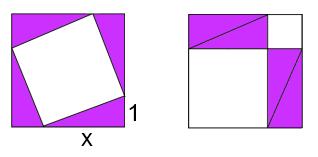Or search by topic
Number and algebra
Geometry and measure
Probability and statistics
Working mathematically
Advanced mathematics
For younger learners
Tilted Squares



- Problem
- Getting Started
- Student Solutions
- Teachers' Resources
Why do this problem?
This problem offers an opportunity to spot patterns, make generalisations and eventually discover Pythagoras's Theorem, while giving students the chance to practise working out areas of squares and right-angled triangles.
Possible approach
This printable worksheet may be useful: Tilted Squares.
The video below shows Charlie and Alison from the NRICH team introducing the problem to a group of Year 9 students who came to visit the Maths Department at Cambridge. Video footage of the later stages of the lesson appear further down the page.
Here is a description based on the approach used by a teacher with a Year 8 class, interspersed with some more video footage from the lesson in Cambridge:
I established that everyone could work out the area of squares when they were in the usual orientation:
Students were all asked to work out the area of their squares and I then collected their results:

Finally, algebraic or pictorial approaches used to justify earlier conjectures can be adapted to prove Pythagoras's Theorem:
An 'x across, 1 up' tilted square can be enclosed by a square of side length x + 1. The area
of the tilted square is $(x + 1)^2$ minus the areas of the four unwanted triangles. This equals
$(x^2 + 2x + 1) - 2x = x^2 + 1$, as predicted.
An 'x across, 2 up' tilted square can be enclosed by a square of side length x + 2. The area of the tilted square is $(x + 2)^2$ minus the areas of the four unwanted triangles. This equals
$(x^2 + 4x + 4) - 4x = x^2 + 4$, as predicted.
An 'x across, y up' tilted square can be enclosed by a square of side length x + y. The area of the tilted square is $(x + y)^2$ minus the areas of the four unwanted triangles. This equals $(x^2 + 2xy + y^2) - 2xy = x^2 + y^2$, as predicted.
Follow-up lessons could focus on working out the lengths of the sides of right-angled triangles when two lengths have been given.
Key questions
Possible support
Start with Square It or Square Coordinates to help students become confident at drawing tilted squares.
Possible extension
It is possible to draw squares with areas of 1, 2, 4, 5, 8, 9... but not 3, 6, 7, 11, 12...
NOTES AND BACKGROUND Ken Nisbet, Mathematics teacher at Madras College in Fife, Scotland, has added:
"I used tilted squares as the basis of individual/group work with a top set (age 14). They were given time to explore this as an open ended question in groups in a brain storming session. Write ups were to be done individually, partly in class but completed at home. This is an important stage in the pupils' mathematical development where the idea of "proof" is coming to the fore. This excellent investigation allows algebra to come to the fore as the language of generalisation and the means of "proof" of patterns. At this stage algebra skills are limited but we have now used this investigation as a springboard to developing necessary algebra skills - e.g. double brackets, squares, expressions etc."
You may also like
Is There a Theorem?
Draw a square. A second square of the same size slides around the first always maintaining contact and keeping the same orientation. How far does the dot travel?

